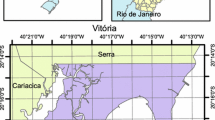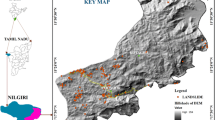Abstract
This paper is devoted to describe a new method of fuzzy logic applied to multi geohazards macro-zone maps. The basic steps are (1) compilation of macro-zone maps for each type of geohazard phenomenon. Each phenomenon is then assigned one of seven geohazard zones: very low, low, relatively low, moderate, relatively high, high, and very high; (2) definition of a membership function using a fuzzy logic algorithm to quantify the qualitative data, estimate a geohazard grade for each mesh point, and to convert qualitative maps to quantitative maps; (3) computation of the summed hazard grade for each mesh point and creation a cumulative geohazard map; and (4) compilation of a multi geohazards macro-zone map by defining a mathematical algorithm and again using fuzzy logic. The paper also describes a mechanism that takes subjective engineering judgments into account. Finally, a geohazard map with a scale of 1:25,000 (Rahdar district, Khuzestan, Iran) is compiled. This study divides the area into seven geohazard macro-zones. Zones of high and very high geohazard classification cover most of the area due to the large number of sinkholes and asymmetric subsidences, rock falls and other slop movements. Low and very low hazard zones only cover small localities.






Similar content being viewed by others
References
Bonham-Carter GF (1994) Geographic information systems for geoscientists: Modelling with GIS. Pergamon, Ontario, Canada
Carrara A, Cardinali M, Guzzetti F, Reichenbach P (1995) GIS technology in mapping landslide hazard. Geographical information systems in assessing natural hazards. Kluwer Academic Publishers, Dordrecht, The Netherlands, pp 135–175
Champati ray PK (1996) Landslide hazard zonation using fuzzy logic and probability analysis in western Himalayas. Project report under IIRS-ITC programme, internal publication. ITC, Netherlands
Champati ray PK (2004) GIS based landslide modelling. In: Nagarajan R (ed) Landslide disaster: assessment and monitoring. Anmol Publications, New Delhi, pp 81–96
Chung CF, Fabbri AG (1993) Representation of geosciences information for data integration, 29th International Geology Conferrence, Kyoto, Japan, pp 11
Chung CF, Fabbri AG, Van Westen CJ (1995) Multivariate regression analysis for landslide hazard zonation. In: Carrera A, Guzzetti F (eds) Geographical information systems in assessing natural hazards. Kluwer Academic Publishers, Dordrecht, The Netherlands, pp 107–133
IDRISI (1995) The decision support ring, IDRISI user manual ver. 4
Ramazi HR (2007) Technical report of geohazard macro-zoning map (1:25 000) of Rahdar region, Iran (in Persian)
Rao SVLN, Prasad J (1982) Definition of kriging in terms of fuzzy logic. Math Geol 14:(1)37–42
Saaty TL (1978) Exploring the interface between hierarchies, multiple objectives and fuzzy sets. J Fuzzy Sets Syst 1:57–68
Taboada J et al (2006) Fuzzy expert system for economic zonation of an ornamental slate deposit. Eng Geol 84:220–228
Van Westen CJ (1993) GISSIZ training package for geographic information systems in slope instability zonation, UNESCO-ITC Project. ITC Publication No. 15, Enschede
Yin KL, Yan TZ (1988) Statistical prediction models for slope instability of metamorphosed rocks. Proceedings of 5th international symposium on landslides, vol. 2, Lausanne, 1269–1272
Zadeh L (1965) Fuzzy sets. IEEE Inf Control 8:125–151
Zadeh L (1978) Fuzzy sets as a basis for a theory of possibility. J Fuzzy Sets Syst 1:3–28
Author information
Authors and Affiliations
Corresponding author
Rights and permissions
About this article
Cite this article
Ramazi, H., Amini, A. Fuzzy logic application in compiling multi geohazards macro-zone maps; case study: Rahdar, 1:25,000 Quadrangle, Khuzestan, Iran. Arab J Geosci 7, 3243–3249 (2014). https://doi.org/10.1007/s12517-013-0943-0
Received:
Accepted:
Published:
Issue Date:
DOI: https://doi.org/10.1007/s12517-013-0943-0




